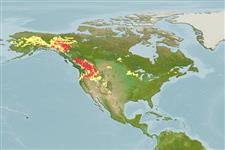Classification / Names
Noms communs | Synonymes | Catalog of Fishes (gen., sp.) | ITIS | CoL | WoRMS | Cloffa
Actinoptérygiens (poissons à nageoires rayonnées) >
Cypriniformes (Carps) >
Catostomidae (Suckers) > Catostominae
Etymology: Catostomus: Greek, kata = down + Greek, stoma = mouth (Ref. 45335); macrocheilus: macrocheilus meaning large lip (Ref. 1998). More on author: Girard.
Environnement / Climat / Gamme
Écologie
; eau douce démersal; profondeur 1 - 80 m (Ref. 1998). Temperate, preferred ?; 54°N - 41°N
North America: Arctic basin in Canada from Peace River drainage in British Columbia to Smokey River drainage in Alberta; Pacific Slope from Nass River in British Columbia to Snake River drainage (below Shoshone Falls) in Idaho and Nevada, USA, and Coquille River in Oregon, USA.
Taille / Poids / Âge
Maturity: Lm ? range ? - ? cm
Max length : 61.0 cm TL mâle / non sexé; (Ref. 5723); common length : 25.0 cm TL mâle / non sexé; (Ref. 12193); âge max. reporté: 15 années (Ref. 12193)
Occurs in pools and runs of medium to large rivers. Also found in lakes. Pelagic up to 1.8 cm in length (Ref. 1998). Young feed on planktonic cladocerans, copepods, ostracods, and mites; chironomid, trichopteran and ephemeropteran larvae; and bottom ooze (Ref. 1998). Adults feed on algae, diatoms, insects, amphipods, and mollusks (Ref. 1998). May feed on salmonid eggs (Ref. 1998). Preyed upon by mergansers, osprey, eagles, and bears (Ref. 1998). Edible but not highly favored (Ref. 1998).
Life cycle and mating behavior
Maturité | Reproduction | Frai | Œufs | Fécondité | Larves
Page, L.M. and B.M. Burr, 1991. A field guide to freshwater fishes of North America north of Mexico. Houghton Mifflin Company, Boston. 432 p. (Ref. 5723)
Statut dans la liste rouge de l'IUCN (Ref. 115185)
CITES (Ref. 94142)
Not Evaluated
Menace pour l'homme
Harmless
Utilisations par l'homme
Pêcheries: commercial; Aquarium: Aquariums publics
Plus d'informations
Taille/ÂgeCroissanceLongueur-poidsLongueur-longueurFréquences de longueursMorphométrieMorphologieLarvesDynamique des populations larvairesRecrutementAbondance
RéférencesAquacultureProfil d'aquacultureSouchesGénétiqueFréquences alléliquesHéritabilitéPathologiesTraitementMass conversion
CollaborateursImagesStamps, CoinsSonsCiguateraVitesseType de nageSurface branchialeOtolithesCerveauxVision
Outils
Articles particuliers
Télécharger en XML
Sources Internet
